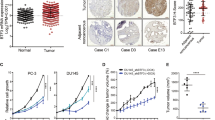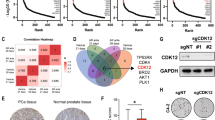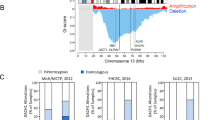Abstract
Prostate cancer (PCa) is the most commonly diagnosed non-cutaneous cancer in men in the western world. Mutations in tumor suppressor genes and in oncogenes are important for PCa progression, whereas the role of stem cell proteins in prostate carcinogenesis is insufficiently examined. This study investigates the role of the transcriptional regulator Ecotropic Viral Integration site 1 (EVI1), known as an essential modulator of hematopoietic and leukemic stem cell biology, in prostate carcinogenesis. We show that in healthy prostatic tissue, EVI1 expression is confined to the prostate stem cell compartment located at the basal layer, as identified by the stem cell marker CD44. Instead, in a PCa progression cohort comprising 219 samples from patients with primary PCa, lymph node and distant metastases, EVI1 protein was heterogeneously distributed within samples and high expression is associated with tumor progression (P<0.001), suggesting EVI1 induction as a driver event. Functionally, short hairpin RNA-mediated knockdown of EVI1 inhibited proliferation, cell cycle progression, migratory capacity and anchorage-independent growth of human PCa cells, while enhancing their apoptosis sensitivity. Interestingly, modulation of EVI1 expression also strongly regulated stem cell properties (including expression of the stem cell marker SOX2) and in vivo tumor initiation capacity. Further emphasizing a functional correlation between EVI1 induction and tumor progression, upregulation of EVI1 expression was noted in experimentally derived docetaxel-resistant PCa cells. Importantly, knockdown of EVI1 in these cells restored sensitivity to docetaxel, in part by downregulating anti-apoptotic BCL2. Together, these data indicate EVI1 as a novel molecular regulator of PCa progression and therapy resistance that may control prostate carcinogenesis at the stem cell level.
This is a preview of subscription content, access via your institution
Access options
Subscribe to this journal
Receive 50 print issues and online access
$259.00 per year
only $5.18 per issue
Buy this article
- Purchase on Springer Link
- Instant access to full article PDF
Prices may be subject to local taxes which are calculated during checkout






Similar content being viewed by others
References
Siegel RL, Miller KD, Jemal A . Cancer statistics, 2015. Cancer J Clin 2015; 65: 5–29.
Fraser M, Berlin A, Bristow RG, van der Kwast T . Genomic, pathological, and clinical heterogeneity as drivers of personalized medicine in prostate cancer. Urol Oncol 2015; 33: 85–94.
Beltran H, Rickman DS, Park K, Chae SS, Sboner A, MacDonald TY et al. Molecular characterization of neuroendocrine prostate cancer and identification of new drug targets. Cancer Discov 2011; 1: 487–495.
De Marzo AM, Platz EA, Sutcliffe S, Xu J, Gronberg H, Drake CG et al. Inflammation in prostate carcinogenesis. Nat Rev Cancer 2007; 7: 256–269.
Mosquera JM, Beltran H, Park K, MacDonald TY, Robinson BD, Tagawa ST et al. Concurrent AURKA and MYCN gene amplifications are harbingers of lethal treatment-related neuroendocrine prostate cancer. Neoplasia 2013; 15: 1–10.
Sethi S, Kong D, Land S, Dyson G, Sakr WA, Sarkar FH . Comprehensive molecular oncogenomic profiling and miRNA analysis of prostate cancer. Am J Transl Res 2013; 5: 200–211.
Perner S, Demichelis F, Beroukhim R, Schmidt FH, Mosquera JM, Setlur S et al. TMPRSS2:ERG fusion-associated deletions provide insight into the heterogeneity of prostate cancer. Cancer Res 2006; 66: 8337–8341.
Mosquera JM, Perner S, Demichelis F, Kim R, Hofer MD, Mertz KD et al. Morphological features of TMPRSS2-ERG gene fusion prostate cancer. J Pathol 2007; 212: 91–101.
Pflueger D, Rickman DS, Sboner A, Perner S, LaFargue CJ, Svensson MA et al. N-myc downstream regulated gene 1 (NDRG1) is fused to ERG in prostate cancer. Neoplasia 2009; 11: 804–811.
Tomlins SA, Rhodes DR, Perner S, Dhanasekaran SM, Mehra R, Sun XW et al. Recurrent fusion of TMPRSS2 and ETS transcription factor genes in prostate cancer. Science 2005; 310: 644–648.
Barjesteh van Waalwijk, van Doorn-Khosrovani S, Erpelinck C, van Putten WL, Valk PJ, van der Poel-van de Luytgaarde S, Hack R et al. High EVI1 expression predicts poor survival in acute myeloid leukemia: a study of 319 de novo AML patients. Blood 2003; 101: 837–845.
Sattler HP, Lensch R, Rohde V, Zimmer E, Meese E, Bonkhoff H et al. Novel amplification unit at chromosome 3q25-q27 in human prostate cancer. Prostate 2000; 45: 207–215.
Goyama S, Kurokawa M . Evi-1 as a critical regulator of leukemic cells. Int J Hematol 2010; 91: 753–757.
Kataoka K, Kurokawa M . Ecotropic viral integration site 1, stem cell self-renewal and leukemogenesis. Cancer Sci 2012; 103: 1371–1377.
Konantz M, Andre MC, Ebinger M, Grauer M, Wang H, Grzywna S et al. EVI-1 modulates leukemogenic potential and apoptosis sensitivity in human acute lymphoblastic leukemia. Leukemia 2013; 27: 56–65.
Mucenski ML, Taylor BA, Ihle JN, Hartley JW, Morse HC 3rd, Jenkins NA et al. Identification of a common ecotropic viral integration site, Evi-1, in the DNA of AKXD murine myeloid tumors. Mol Cell Biol 1988; 8: 301–308.
Wieser R . The oncogene and developmental regulator EVI1: expression, biochemical properties, and biological functions. Gene 2007; 396: 346–357.
Deng X, Cao Y, Liu Y, Li F, Sambandam K, Rajaraman S et al. Overexpression of Evi-1 oncoprotein represses TGF-beta signaling in colorectal cancer. Mol Carcinogenesis 2013; 52: 255–264.
Dutta P, Bui T, Bauckman KA, Keyomarsi K, Mills GB, Nanjundan M . EVI1 splice variants modulate functional responses in ovarian cancer cells. Mol Oncol 2013; 7: 647–668.
Nayak KB, Kuila N, Das Mohapatra A, Panda AK, Chakraborty S . EVI1 targets DeltaNp63 and upregulates the cyclin dependent kinase inhibitor p21 independent of p53 to delay cell cycle progression and cell proliferation in colon cancer cells. Int J Biochem Cell Biol 2013; 45: 1568–1576.
Patel JB, Appaiah HN, Burnett RM, Bhat-Nakshatri P, Wang G, Mehta R et al. Control of EVI-1 oncogene expression in metastatic breast cancer cells through microRNA miR-22. Oncogene 2011; 30: 1290–1301.
Bard-Chapeau EA, Jeyakani J, Kok CH, Muller J, Chua BQ, Gunaratne J et al. Ecotopic viral integration site 1 (EVI1) regulates multiple cellular processes important for cancer and is a synergistic partner for FOS protein in invasive tumors. Proc Natl Acad Sci USA 2012; 109: 2168–2173.
Aytekin M, Vinatzer U, Musteanu M, Raynaud S, Wieser R . Regulation of the expression of the oncogene EVI1 through the use of alternative mRNA 5′-ends. Gene 2005; 356: 160–168.
Brooks DJ, Woodward S, Thompson FH, Dos Santos B, Russell M, Yang JM et al. Expression of the zinc finger gene EVI-1 in ovarian and other cancers. Br J Cancer 1996; 74: 1518–1525.
Yu Z, Pestell TG, Lisanti MP, Pestell RG . Cancer stem cells. Int J Biochem Cell Biol 2012; 44: 2144–2151.
Chen X, Rycaj K, Liu X, Tang DG . New insights into prostate cancer stem cells. Cell Cycle 2013; 12: 579–586.
van Leenders GJ, Schalken JA . Stem cell differentiation within the human prostate epithelium: implications for prostate carcinogenesis. BJU Int 2001; 88: 35–42 discussion 49–50.
Volkert S, Schnittger S, Zenger M, Kern W, Haferlach T, Haferlach C . Amplification of EVI1 on cytogenetically cryptic double minutes as new mechanism for increased expression of EVI1. Cancer Genet 2014; 207: 103–108.
Cerami E, Gao J, Dogrusoz U, Gross BE, Sumer SO, Aksoy BA et al. The cBio cancer genomics portal: an open platform for exploring multidimensional cancer genomics data. Cancer Discov 2012; 2: 401–404.
Gao J, Aksoy BA, Dogrusoz U, Dresdner G, Gross B, Sumer SO et al. Integrative analysis of complex cancer genomics and clinical profiles using the cBioPortal. Sci Signal 2013; 6: pl1.
Baca SC, Prandi D, Lawrence MS, Mosquera JM, Romanel A, Drier Y et al. Punctuated evolution of prostate cancer genomes. Cell 2013; 153: 666–677.
Barbieri CE, Baca SC, Lawrence MS, Demichelis F, Blattner M, Theurillat JP et al. Exome sequencing identifies recurrent SPOP, FOXA1 and MED12 mutations in prostate cancer. Nat Genet 2012; 44: 685–689.
Cancer Genome Atlas Research N. The molecular taxonomy of primary prostate cancer. Cell 2015; 163: 1011–1025.
Gao D, Vela I, Sboner A, Iaquinta PJ, Karthaus WR, Gopalan A et al. Organoid cultures derived from patients with advanced prostate cancer. Cell 2014; 159: 176–187.
Grasso CS, Wu YM, Robinson DR, Cao X, Dhanasekaran SM, Khan AP et al. The mutational landscape of lethal castration-resistant prostate cancer. Nature 2012; 487: 239–243.
Hieronymus H, Schultz N, Gopalan A, Carver BS, Chang MT, Xiao Y et al. Copy number alteration burden predicts prostate cancer relapse. Proc Natl Acad Sci USA 2014; 111: 11139–11144.
Kumar A, Coleman I, Morrissey C, Zhang X, True LD, Gulati R et al. Substantial interindividual and limited intraindividual genomic diversity among tumors from men with metastatic prostate cancer. Nat Med 2016; 22: 369–378.
Robinson D, Van Allen EM, Wu YM, Schultz N, Lonigro RJ, Mosquera JM et al. Integrative clinical genomics of advanced prostate cancer. Cell 2015; 161: 1215–1228.
Taylor BS, Schultz N, Hieronymus H, Gopalan A, Xiao Y, Carver BS et al. Integrative genomic profiling of human prostate cancer. Cancer Cell 2010; 18: 11–22.
Kaighn ME, Narayan KS, Ohnuki Y, Lechner JF, Jones LW . Establishment and characterization of a human prostatic carcinoma cell line (PC-3). Invest Urol 1979; 17: 16–23.
Pedrali-Noy G, Spadari S, Miller-Faures A, Miller AO, Kruppa J, Koch G . Synchronization of HeLa cell cultures by inhibition of DNA polymerase alpha with aphidicolin. Nucleic Acids Res 1980; 8: 377–387.
Kurokawa M, Mitani K, Irie K, Matsuyama T, Takahashi T, Chiba S et al. The oncoprotein Evi-1 represses TGF-beta signalling by inhibiting Smad3. Nature 1998; 394: 92–96.
Pardali K, Kowanetz M, Heldin CH, Moustakas A . Smad pathway-specific transcriptional regulation of the cell cycle inhibitor p21(WAF1/Cip1). J Cell Physiol 2005; 204: 260–272.
Liu Y, Chen L, Ko TC, Fields AP, Thompson EA . Evi1 is a survival factor which conveys resistance to both TGFbeta- and taxol-mediated cell death via PI3K/AKT. Oncogene 2006; 25: 3565–3575.
Bareiss PM, Paczulla A, Wang H, Schairer R, Wiehr S, Kohlhofer U et al. SOX2 expression associates with stem cell state in human ovarian carcinoma. Cancer Res 2013; 73: 5544–5555.
Fan X, Liu S, Su F, Pan Q, Lin T . Effective enrichment of prostate cancer stem cells from spheres in a suspension culture system. Urol Oncol 2012; 30: 314–318.
Wang H, Paczulla A, Lengerke C . Evaluation of stem cell properties in human ovarian carcinoma cells using multi and single cell-based spheres assays. J Vis Exp 2015; 95: e52259.
Konantz M, Balci TB, Hartwig UF, Dellaire G, Andre MC, Berman JN et al. Zebrafish xenografts as a tool for in vivo studies on human cancer. Ann N Y Acad Sci 2012; 1266: 124–137.
Schaefer T, Wang H, Mir P, Konantz M, Pereboom TC, Paczulla AM et al. Molecular and functional interactions between AKT and SOX2 in breast carcinoma. Oncotarget 2015; 6: 43540–43556.
Souers AJ, Leverson JD, Boghaert ER, Ackler SL, Catron ND, Chen J et al. ABT-199, a potent and selective BCL-2 inhibitor, achieves antitumor activity while sparing platelets. Nat Med 2013; 19: 202–208.
Nanjundan M, Nakayama Y, Cheng KW, Lahad J, Liu J, Lu K et al. Amplification of MDS1/EVI1 and EVI1, located in the 3q26.2 amplicon, is associated with favorable patient prognosis in ovarian cancer. Cancer Res 2007; 67: 3074–3084.
Tanaka M, Suzuki HI, Shibahara J, Kunita A, Isagawa T, Yoshimi A et al. EVI1 oncogene promotes KRAS pathway through suppression of microRNA-96 in pancreatic carcinogenesis. Oncogene 2014; 33: 2454–2463.
Nwachukwu JC, Mita P, Ruoff R, Ha S, Wang Q, Huang SJ et al. Genome-wide impact of androgen receptor trapped clone-27 loss on androgen-regulated transcription in prostate cancer cells. Cancer Res 2009; 69: 3140–3147.
Taneja SS, Ha S, Swenson NK, Torra IP, Rome S, Walden PD et al. ART-27, an androgen receptor coactivator regulated in prostate development and cancer. J Biol Chem 2004; 279: 13944–13952.
McGilvray R, Walker M, Bartholomew C . UXT interacts with the transcriptional repressor protein EVI1 and suppresses cell transformation. FEBS J 2007; 274: 3960–3971.
Rosa-Ribeiro R, Nishan U, Vidal RO, Barbosa GO, Reis LO, Cesar CL et al. Transcription factors involved in prostate gland adaptation to androgen deprivation. PLoS ONE 2014; 9: e97080.
Kerr CL, Hussain A . Regulators of prostate cancer stem cells. Cuee Opin Oncol 2014; 26: 328–333.
Li P, Yang R, Gao WQ . Contributions of epithelial-mesenchymal transition and cancer stem cells to the development of castration resistance of prostate cancer. Mol Cancer 2014; 13: 55.
Tu SM, Lin SH . Prostate cancer stem cells. Clin Genitourinary Cancer 2012; 10: 69–76.
Schroeder A, Herrmann A, Cherryholmes G, Kowolik C, Buettner R, Pal S et al. Loss of androgen receptor expression promotes a stem-like cell phenotype in prostate cancer through STAT3 signaling. Cancer Res 2014; 74: 1227–1237.
Kregel S, Kiriluk KJ, Rosen AM, Cai Y, Reyes EE, Otto KB et al. Sox2 is an androgen receptor-repressed gene that promotes castration-resistant prostate cancer. PLoS ONE 2013; 8: e53701.
Han L, Shi S, Gong T, Zhang Z, Sun X . Cancer stem cells: therapeutic implications and perspectives in cancer therapy. Acta Pharma Sin B 2013; 3: 65–75.
Zhang B, Shimada Y, Kuroyanagi J, Nishimura Y, Umemoto N, Nomoto T et al. Zebrafish xenotransplantation model for cancer stem-like cell study and high-throughput screening of inhibitors. Tumour Biol 2014; 35: 11861–11869.
Kustikova OS, Schwarzer A, Stahlhut M, Brugman MH, Neumann T, Yang M et al. Activation of Evi1 inhibits cell cycle progression and differentiation of hematopoietic progenitor cells. Leukemia 2013; 27: 1127–1138.
Shackelford D, Kenific C, Blusztajn A, Waxman S, Ren R . Targeted degradation of the AML1/MDS1/EVI1 oncoprotein by arsenic trioxide. Cancer Res 2006; 66: 11360–11369.
Scheble VJ, Braun M, Beroukhim R, Mermel CH, Ruiz C, Wilbertz T et al. ERG rearrangement is specific to prostate cancer and does not occur in any other common tumor. Mod Pathol 2010; 23: 1061–1067.
Braun M, Goltz D, Shaikhibrahim Z, Vogel W, Bohm D, Scheble V et al. ERG protein expression and genomic rearrangement status in primary and metastatic prostate cancer—a comparative study of two monoclonal antibodies. Prostate Cancer Prostatic Dis 2012; 15: 165–169.
Choi J, Dong L, Ahn J, Dao D, Hammerschmidt M, Chen JN . FoxH1 negatively modulates flk1 gene expression and vascular formation in zebrafish. Dev Biol 2007; 304: 735–744.
Haldi M, Ton C, Seng WL, McGrath P . Human melanoma cells transplanted into zebrafish proliferate, migrate, produce melanin, form masses and stimulate angiogenesis in zebrafish. Angiogenesis 2006; 9: 139–151.
Acknowledgements
The study was supported by a grant from the German Research Foundation (Deutsche Forschungsgemeinschaft (PE 1179/11-1)) to SP, the Schweizer Nationalfonds to CL (310030_149735), the Rudolf-Becker-Foundation and the Wilhelm-Sander-Foundation (2011.077.2) to SP and the German Cancer Aid (Mildred-Scheel Doctoral Student Fellowship) to SH. We also acknowledge the TCGA Research Network for providing their cancer data sets.
Author contributions
AQ, SH, HW, CL and SP designed the study. AQ, SH, HW and TS performed the in vitro experiments. WV performed the immunohistochemistry stains. MK performed the in vivo zebrafish experiments. SA generated the docetaxel-resistant cell lines. SH performed the statistics. MD performed the cBioPortal analysis. AQ, SH, HW, MK, AvM, GK, SD, TS, JK, CL and SP analyzed and interpreted the data. AQ, SH, HW, CL and SP wrote the manuscript.
Author information
Authors and Affiliations
Corresponding authors
Ethics declarations
Competing interests
The authors declare no conflict of interest.
Additional information
Supplementary Information accompanies this paper on the Oncogene website
Rights and permissions
About this article
Cite this article
Queisser, A., Hagedorn, S., Wang, H. et al. Ecotropic viral integration site 1, a novel oncogene in prostate cancer. Oncogene 36, 1573–1584 (2017). https://doi.org/10.1038/onc.2016.325
Received:
Revised:
Accepted:
Published:
Issue Date:
DOI: https://doi.org/10.1038/onc.2016.325
This article is cited by
-
Allergen-Immuntherapie in der aktuellen Covid-19-Pandemiea, b, c
Allergo Journal (2020)
-
EVI1 promotes epithelial-to-mesenchymal transition, cancer stem cell features and chemo−/radioresistance in nasopharyngeal carcinoma
Journal of Experimental & Clinical Cancer Research (2019)



